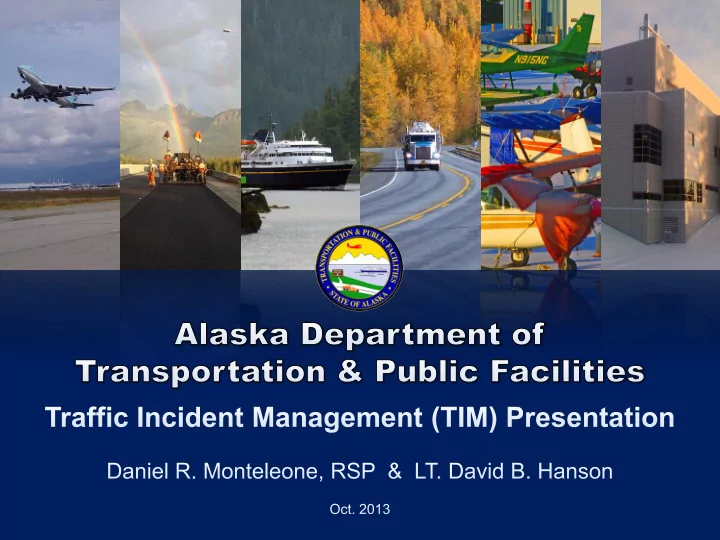

Traffic Incident Management The State of Alaska Department of Transportation and Public Facilities and the Department of Public Safety have reviewed this presentation for state agency coordination. Integrity ∙ Excellence ∙ Respect
Traffic Incidents Whenever significant traffic incidents occur they impede the normal flow of traffic. In recent years there have been a number of Traffic incidents in our larger populated areas i.e. Anchorage Bowl, Mat-Su Valley and Kenai Peninsula that have seriously interrupted traffic flow. These incidents usually involve serious vehicle damages, fatalities or criminal activity which require specially trained enforcement officers to secure and assess the scene in the aftermath. When the traffic flow in these areas is delayed for an extended periods of time it causes a large ripple effect to a significant number of the population which causes additional impacts. As these areas of our state continue to grow the problem grows along with it. Integrity ∙ Excellence ∙ Respect
IN STATE TRAFFIC DELAYS
IN STATE TRAFFIC DELAYS
IN STATE TRAFFIC DELAYS
IN STATE TRAFFIC DELAYS
Strategic Highway Research Program (SHRP2) Congress authorized the second Strategic Highway Research Program (SHRP2) in 2005. This program was designed to investigate the underlying causes of highway crashes and congestion through competitively awarded research contracts. SHRP 2 addresses four strategic focus areas: 1. The role of human behavior in highway safety (Safety) 2. Rapid highway renewal (Renewal) 3. Congestion reduction through improved travel time reliability (Reliability) 4. Transportation planning that better integrates community, economic, and environmental considerations into a new highway capacity (Capacity). The Federal Highway Administration (FHWA) has developed training to assist in this endeavor. Integrity ∙ Excellence ∙ Respect
Strategic Highway Research Program (SHRP2) Training Is this training mandatory? Traffic Incident Management (TIM) training is not mandatory, but all responders are strongly encouraged to participate. TIM training can reduce the number of responders injured and killed at traffic incidents, help relieve traffic congestion, and improve incident communications. Each State and Territory has the flexibility to determine which training option fits the needs of their Responder community (e.g., full 16 hour course, condensed 4 hour course, or specific training modules). Regardless of the option used, all States and Territories are strongly encouraged to offer regularly scheduled TIM training.
Strategic Highway Research Program (SHRP2) Training Who should attend the Traffic Incident Management (TIM) Responder (student) training? The target audiences for classroom training are all potential traffic incident responders, including: • Law enforcement officers • Fire and rescue personnel • Transportation professionals (e.g., operations and maintenance staff) • Public works personnel (e.g., city engineers, traffic engineers) • Emergency medical services (EMS) personnel • Towing and recovery personnel • Hazardous material (HAZMAT) responders • Coroners/medical examiners.
Strategic Highway Research Program (SHRP2) Training What funding is available? The Federal Highway Administration (FHWA) provides Train-the-Trainer (TtT) courses to prepare hundreds of instructors on how to teach TIM principles in a standardized manner based on curriculum developed under the original SHRP2 Reliability Research Project. It is anticipated that States and Territorial responder communities will then work with the instructors to incorporate TIM Responder courses into their existing training offerings.
Strategic Highway Research Program (SHRP2) Training How many responders does the Federal Highway Administration (FHWA) intend to train under this program? FHWA has set a goal to conduct 40 to 60 TtT sessions across the Nation by July 2014. Through this program, 1,000 to 1,500 State/Local trainers will be trained to teach standard TIM practices using a common curriculum. Instructors from those sessions will then deliver classroom training to 30,000 to 40,000 incident responders by July 2014. By 2022, FHWA expects to─ Train 4,500 trainers to deliver classroom training. Deliver classroom training to 425,000-900,000 Responders. Deliver E-Learning to 1,200,000 Responders.
Strategic Highway Research Program (SHRP2) Training Why should I attend this training? TIM Responder Training was developed for a multidisciplinary audience with a specific emphasis on Responder safety. Training materials incorporate standardized curriculum developed under the SHRP2 Reliability Research Project. The interactive nature of this classroom training strongly encourages communication and collaboration across various disciplines and gives stakeholders an opportunity to discuss TIM policies and practices specific to their State or Territory.
Strategic Highway Research Program (SHRP2) Training What resources are available to help complete the Implementation Plan? The (FHWA) Implementation Plan Template has been completed which is used to assist the States and Territories in developing and updating their respective Implementation Plans.
TIM Training The First training sessions are tentatively set for later this year. These sessions will be directed at Emergency Responders and are geared toward the Train the Trainer (TtT) level. The Federal Highway Administration (FHWA) Implementation Plan Template has been completed and the Federal contract training team is tentatively scheduled to be in the Anchorage and Fairbanks areas to begin the training in November. Later the personnel with the TtT will be making the training available to responders in their areas.
Statewide Traffic Operations Center (STOC) The department recently gave a notice to proceed for a service contract to look into the specifics of developing a Statewide Traffic Operations center. The Contractor will look into planning, researching, documenting, agency coordination issues, analysis, alternatives and costs of developing a STOC. The concept will include (ITS) elements such as time travel speed indicators, cameras, weather sensors, message boards and other devices necessary to communicate with travelers law enforcement and emergency responders. To Date the following has occurred: Kick Off Meeting Monthly teleconference with Steering Committee and reports Project Team Website established and Needs Assessment is underway.
Questions? Daniel R. Monteleone, RSP. LT. David B. Hanson (907) 269-6323 (907) 269-5587
Recommend
More recommend